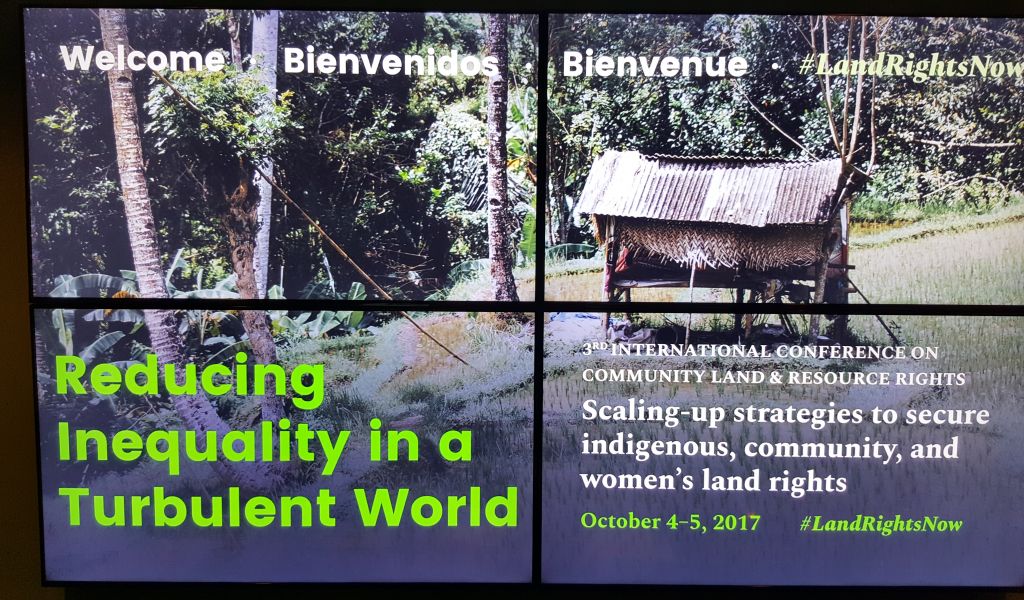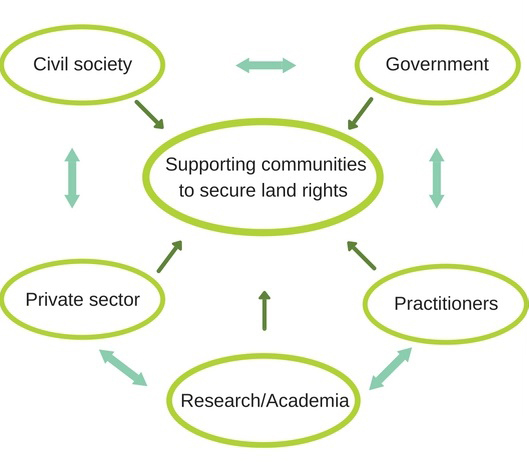Supporting local communities to secure land rights

Over half of the world’s land area is managed through customary, community-based tenure systems by local and indigenous communities that depend on these lands for their livelihoods. However, only 10% of the arable land is formally recognized as being owned by these communities. In addition, there is minimal recognition of the women that make up 43% of the global labour force for agricultural systems. Land ownership is central to providing food, income and savings for the future of women, local communities and Indigenous Peoples; yet, it is rarely equitably allocated or managed. Land security is also fundamental in stimulating investment and growth, particularly when trying to prevent land-grabbing and forced migration.
There is a gap between customarily held and formalized tenure of land which is undermining local, national, and global efforts to reduce poverty, deforestation, and food insecurity. Bridging this gap and recognizing the importance of land tenure is also needed to tackle climate change and gender injustice.
A recent conference in Stockholm brought together 300 people from around 60 countries to discuss: Reducing inequality in a turbulent world: scaling-up strategies to secure indigenous, community, and women’s land rights. The conference, hosted by the Rights and Resources Initiative (RRI) and its partners, highlighted that many countries face similar constraints to formalizing and securing the land rights of local and Indigenous Peoples. Scholars, including those gathered at the conference, have often suggested that these issues could be overcome through increased participation and better engagement among stakeholders to develop inclusive and mutually beneficial partnerships with local and indigenous communities.
Summarized in an RRI video, the conference set out strategies to understand the barriers that must be overcome to help secure land rights for communities and the power of convening a multi-stakeholder dialogue. The land rights movement is vital for identifying potential roles that stakeholders, particularly the private sector, can adopt in supporting local and Indigenous Peoples.
Two of the barriers identified are:
Inadequate legal and regulatory framework (including women’s or Indigenous Peoples’ right to own land); and
Limited capacity among stakeholders for effective collaboration (derived from social and gender injustices, and a lack of political will among government authorities and legal knowledge among communities).
Stakeholder involvement and collaboration have been identified as integral components to formalizing land rights. So what role can the various stakeholders play in ensuring that the voices of local and Indigenous Peoples are actually heard, and that they contribute to recognizing customary land rights?
Governments are key institutions in recognizing customary land rights. Governments, through facilitating development of appropriate policy, law and regulatory means, should ensure that communities have legal documentation and can enjoy clear rights and control of natural resources. More investment is needed in the capacity development of relevant agencies and the skills of their officials. Moreover, government actors should educate communities of their rights and encourage the private sector to follow relevant standards.
The private sector has emerged as a change agent in addressing land tenure issues and inclusive growth. Most notably by recognizing communities' rights to land, including them in production chains, and providing jobs. Many private sector actors are portrayed negatively in the media for failing to acknowledge community land rights, risking their reputation and potentially incurring financial losses. A response for private sector actors should be to develop strategies consistent with international land standards and community needs through intensified communication with local and Indigenous Peoples. An increasing number of private sector actors are becoming aware that improved socio-economic conditions in communities can have positive business impacts. The private sector should also push governments for policy changes that are amenable to land rights justice.
Civil society can be instrumental in supporting governments to overcome capacity and resource gaps in ensuring community land rights. For instance, through working with government to overcome barriers in engaging with communities. Additionally, civil society can pressure policy makers by communicating land rights issues at national or even international levels, and disseminate knowledge to local and Indigenous Peoples about their rights. Civil society organizations should lead partnerships with governments and the private sector to develop sensitive and inclusive strategies for marginalized communities to obtain adequate support and fair internal distribution of benefits.
To scale up partnerships among civil society and the private sector, academia, researchers and practitioners should support other stakeholders by analyzing and highlighting successful examples of long-term business-civil society partnerships, such as the benefits of improved land rights to broader development goals. Communities are often unaware of their resources and land rights and are can be excluded from decision making processes. Still, communities should never be seen as passive bystanders. Through active participation in multi stakeholder dialogue they can work towards getting government, private sector and civil society to support their demands for land rights, and in turn, secure their livelihoods.

Finally, the government, private sector and, in some instances, civil society would benefit from an improved understanding of communities and a forum to discuss recognizing customary land rights in an open and transparent manner. At the next Community Forestry Forum, RECOFTC- The Center for People and Forest and its partners (like RRI and those at the Stockholm conference) will facilitate a neutral gathering that promotes active listening between these various parties.
Active listening is essential to moving past traditional stereotypes of government, private sector, and non-government and civil society organizations. A safe environment for dialogue must be created for these parties to speak about how to move ahead with securing land tenure rights and opportunities to recognize customary, community-based tenure systems. Each participant has to feel that every other participant is acting openly and honestly in the dialogue, with the intention of truly understanding one another. Only in this way can trust between participants be built and a more just land rights system be realized.

